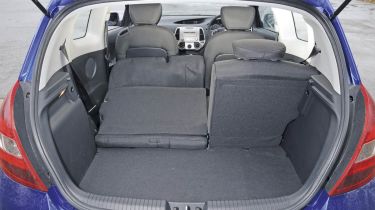Hyundai i20 1.2
Tweaks make baby a stronger choice than ever
Hyundai continues to go from strength to strength. Last year saw a host of new models hit UK showrooms, and the manufacturer recorded its best-ever sales figures in the UK. But it isn’t concentrating solely on its freshest metal – and a policy of constant development ensures that the existing i20 is more attractive than ever.
Launched in 2008, the car was designed to meet the needs of European buyers; it isn’t even sold in the company’s home market of Korea. This focus has paid dividends, although the designers took few risks – the i20 is conventional and well proportioned, and the result is a tidy, if unexciting, supermini.
A range of updates last year left the exterior untouched, but brought about more significant changes inside – where the dashboard and instrument illumination is now blue rather than red. This helps to give a classy appearance at night, while it’s hard to find fault with the silver-effect centre console, smart dashboard materials and simple layout.
The Hyundai is well built, and a height-adjustable driver’s seat, plus reach and rake wheel movement, make it easy to find a comfortable position. Passengers are equally well catered for: the i20 has the longest wheelbase of our trio, which helps it deliver class-leading rear legroom.
Used - available now

2023 Polestar
2
28,503 milesAutomaticElectric
Cash £23,100
2022 Nissan
Qashqai
21,203 milesManualPetrol1.3L
Cash £19,000
2022 Toyota
Corolla
14,897 milesAutomaticPetrol1.8L
Cash £16,663
2024 Volkswagen
Golf GTD
10,576 milesAutomaticDiesel2.0L
Cash £26,697It also leaves its rivals trailing for flexibility, thanks to its 295-litre boot – it’s much bigger than the Suzuki’s paltry 213-litre load area. The car in our pictures is the less practical three-door, but the five-door model we test here is more spacious than its competitors.
It doesn’t disappoint on the road, either. Light controls make it easy to drive, and that long wheelbase aids ride comfort.
Despite this, the i20 isn’t the dynamic leader of our trio, as the Swift is more nimble and fun to drive. Also, the Hyundai’s power-steering has an artificial feel either side of the straight-ahead. Even so, it turns into corners positively, plus it rolls less than the Micra and feels surprisingly at home at motorway speeds for such a small model.
It can’t match the Swift’s fun factor, yet with standard stability control and decent brakes the i20 is a composed and capable choice. To back up this performance, the 1.2-litre motor offers decent pace. It’s the least powerful on test, with 77bhp, but delivers 119Nm of torque – a slender 9Nm more than the Nissan. Add lower gearing, and it provides more responsive in-gear punch.
In the drag from 50-70mph in top, the Hyundai was 2.4 seconds faster than the Micra, with a time of 15 seconds exactly. However, with the heaviest kerbweight of all, it was the slowest here from 0-60mph, taking 11.7 seconds. You have to work the four-cylinder engine hard to make the most of its performance, but it’s relatively refined and the five-speed box has a decent shift action.
So the rounded i20 is good to drive, affordable and well kitted out. And in a test of mid-range value-for-money superminis, it ticks virtually every box.
Details
Chart position: 2
WHY: Latest revisions improve Hyundai’s supermini package – and it was already a great-value family runaround!







